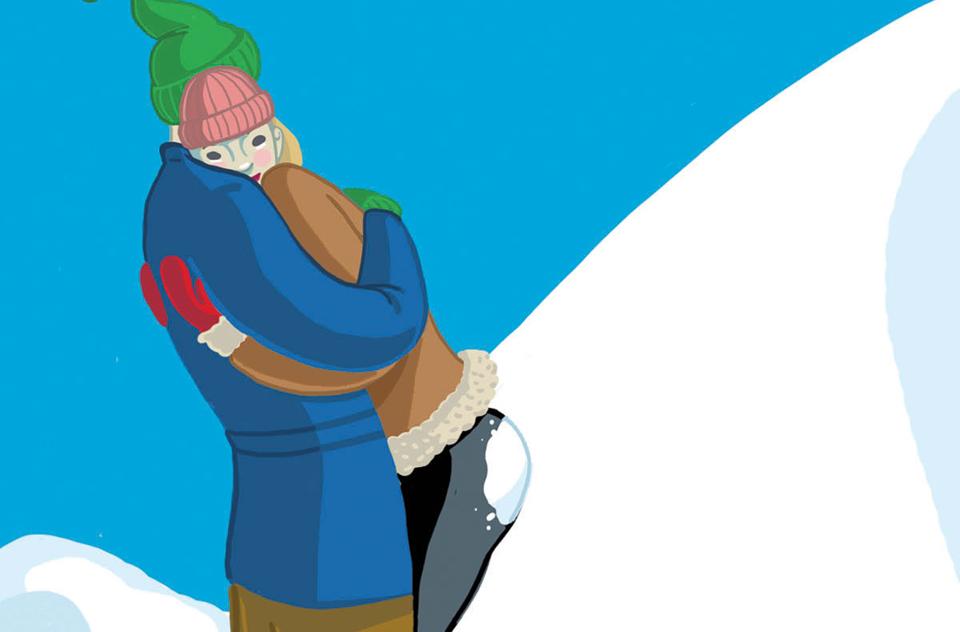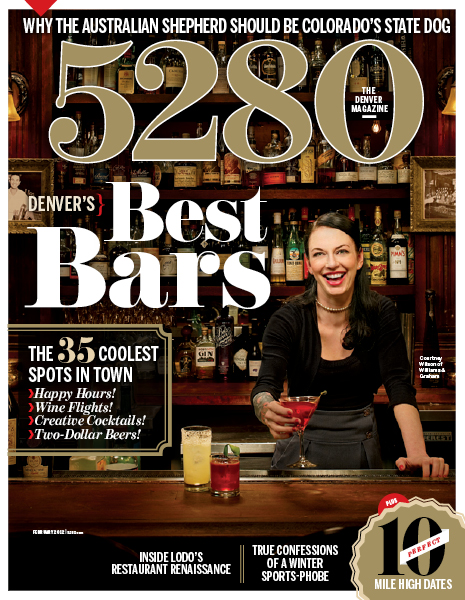The Local newsletter is your free, daily guide to life in Colorado. For locals, by locals.
On any given winter day at the YMCA of the Rockies, kids romp around the Snow Mountain Ranch’s Nordic Center while graybeards sip warm beverages out of thermoses as they pull on another layer of Lycra. The lodge-like registration building overlooks a cozy valley and a distant ridgeline dotted with evergreens that is inevitably covered in pristine powder. It’s the quintessential Colorado postcard shot. And to me, it’s terrifying.
You see, I’m afraid of gravity. In this state of rugged ups and downs and picturesque peaks, I’d rather enjoy the views from an earthbound, stable place. Like my car. I have no urge to go downhill or feel the wind in my hair. Unfortunately, my husband of eight years—and my high school sweetheart—loves playing in the snow.
Which is why, the day after Thanksgiving, I found myself, again, at Snow Mountain Ranch. Chris had been tracking weather reports for weeks and finally concluded that there was enough snow for a “romantic getaway” in the high country. He wasn’t fooling me; he wanted to indulge in some winter sports, and the “romantic” part was a ruse to lure me uphill.
I offered to drive, thinking that the hairpin turns on Berthoud Pass would distract me from what I was about to do. It didn’t work: My palms started sweating as soon as we hit Winter Park, and by the time we arrived at the ranch, my stomach was swirling around my feet, my lip was quivering, and I’d turned into a blabbering, complaining child. I don’t want to ski. I don’t want to go outside. I don’t want to wear those gloves. I don’t want to fall….
***
My adrenaline aversion began on another Thanksgiving weekend, when I was 11. I grew up in about the flattest place imaginable, the plains of southwestern North Dakota, where the highest point is a bump in the landscape called White Butte (elevation: 3,506 feet). Although it’s too frigid to do much outside during the long winter months, my family’s cold-weather sport was sledding, and I was a pro: I could steer, launch over a mogul, and stop on a snowy dime before ending up in someone’s yard. Then one day, someone handed me a sledding tube. The donut-hole opening was too big for my hipless, pre-teen frame, and I kept sliding through until I figured out how to wedge my legs into a V.
The trouble was, this created blind spots, which is why I didn’t see the tree until it was too late. I escaped without any broken bones, but my calf quickly turned violet, topaz, and blood red. I spent a few weeks on crutches but remained undaunted. Soon my dad and I picked out another slope that looked harmless. It wasn’t. The snow-obscured rock I hit on my first run sent me right back to the crutches. Once I could walk again, I gamely gave gravity sports one more try. This time, a renegade pipe, also hiding in snow, ended my run, and the knot on my right leg from that mishap is still there. After my third stint on crutches I vowed to never move faster than my own body can naturally carry me unless I was safely buckled in a car.
A few years later I met Chris. I was a freshman; he was a junior with a letterman’s jacket. I swooned. He was on the tennis team, got straight As, and excelled at just about everything, particularly at the notes he wrote me between classes. He was brilliant and funny and quickly became my best friend. When he left for college, my 16-year-old self said, “Let’s stay together.”
***
And we did—for seven years apart. He went to Texas for college, I went to Massachusetts two years later. He moved to Massachusetts for law school, but I decided to study in the Netherlands. After graduation, I moved to New York. A year later, when he finished law school, he did, too.
My silent hostility toward snow sports and gravity continued—until we moved to Colorado in 2006. I wasn’t worried that Chris would want to do winter sports. He never picks up something just because others are doing it, and that confidence and steadiness is one of the things I love most about him. So I thought I was safe. But by our first Christmas here, he could no longer ignore these spectacular, oh-so accessible mountains, and he gave in. We bought heavy coats. We bought neck gaiters. We bought snowshoes—still within my anti-gravity comfort zone because you can’t move very fast with ducklike contraptions stuck to your feet.
And then, a year or two later, he got us cross-country skis. I’d never been on skis before; to me, “snowplow” is a machine that clears your driveway. On our first trip to Winter Park, we callously waved off a lesson and headed out. Every time Chris turned around, he looked so happy that I’d put on a grin and give him a thumbs-up. He was too far ahead to see the tears streaming down my face and freezing to my cheeks.
At the top of my first slope, the sledding flashbacks started. I had no idea how to ski hills, or even stop. Why did I agree to this again? And without a lesson? Halfway down the gently descending grade, I panicked, slid off the trail, and plunged toward a tree. Hugging the trunk to stop my plummet seemed like the best option for survival. I was wrong. My arms wrapped around the trunk, but so did my head, whacking my skull in that squishy area where your neck meets your cranium. After a few minutes, I could (mostly) see straight, so I took off my skis and walked back to the lodge—with a mild concussion.
***
That was three winters ago, and I still walk down hills. (I wanted to make a helmet part of my cross-country ensemble until Chris convinced me of its unforgiveable geekiness.) In my household, winter sports aren’t going away, and if I want to spend time with my husband on the weekends I’d better get used to it. I still ski in “low gear,” meaning that as soon as it starts to terrify me, I stop. But I have progressed from classic skis to Olympic-racing-style skate skiing. I have a membership to the Devil’s Thumb Ranch cross-country course, and I wear legit gear that makes me look fast, even if I’m more of a snow turtle than a snow bunny.
Despite my tantrum at Snow Mountain Ranch this past November, I actually enjoyed the day. I didn’t fall, and I skied down a mild slope, snowplowing so carefully that Chris went up and down twice during my one descent. I even had what all snow-loving Coloradans seek: a perfect run. Chris was ahead, lifting his poles and gliding like an ice skater. I watched him and focused on the sound of his skis cutting the freshly packed snow. I realized that winter wind carries more decibels and whistles through the trees, and Chris’ skis added to the symphony. That’s when I got it: the snow, the wind, the flawless beauty. Suddenly, the hills didn’t seem to matter anymore. We were doing something my husband loves, despite my reservations. I wasn’t giving up, but giving in, which is what any relationship is about. It was…romantic.
Inspired by my calamity-free experience, we headed to Steamboat Springs the next day. Although we got up early, we weren’t the first skiers on the course; Steamboat’s tracks always seem filled with Olympic-caliber skiers, and on this day the University of Wyoming’s Nordic skiing team—the NCAA men’s and women’s national champions in 2010—was training on the course.
Things were going OK until I noticed that Chris had stopped at the top of a hill. I realized why about two seconds too late. As I shot past him, I desperately turned my skis into a tight snowplow, leaning hard to the left. This was more than just a hill; it was a hill that curved. That’s when I noticed the University of Wyoming racer barreling toward me. I gave up, straightened my legs, veered off the course, and face-planted in a snow bank.
Chris hurried over to ask if I was OK. “I’m done,” I said. He didn’t argue, or protest that we’d paid a whole day’s fee for about 10 minutes of skiing. To him, just getting me out there was worth the effort. Face-plant and all, it was for me, too. We’re both giving in, because we know we’ll get something in return—even if I can’t hope to ever love winter sports as much as I love my husband.









